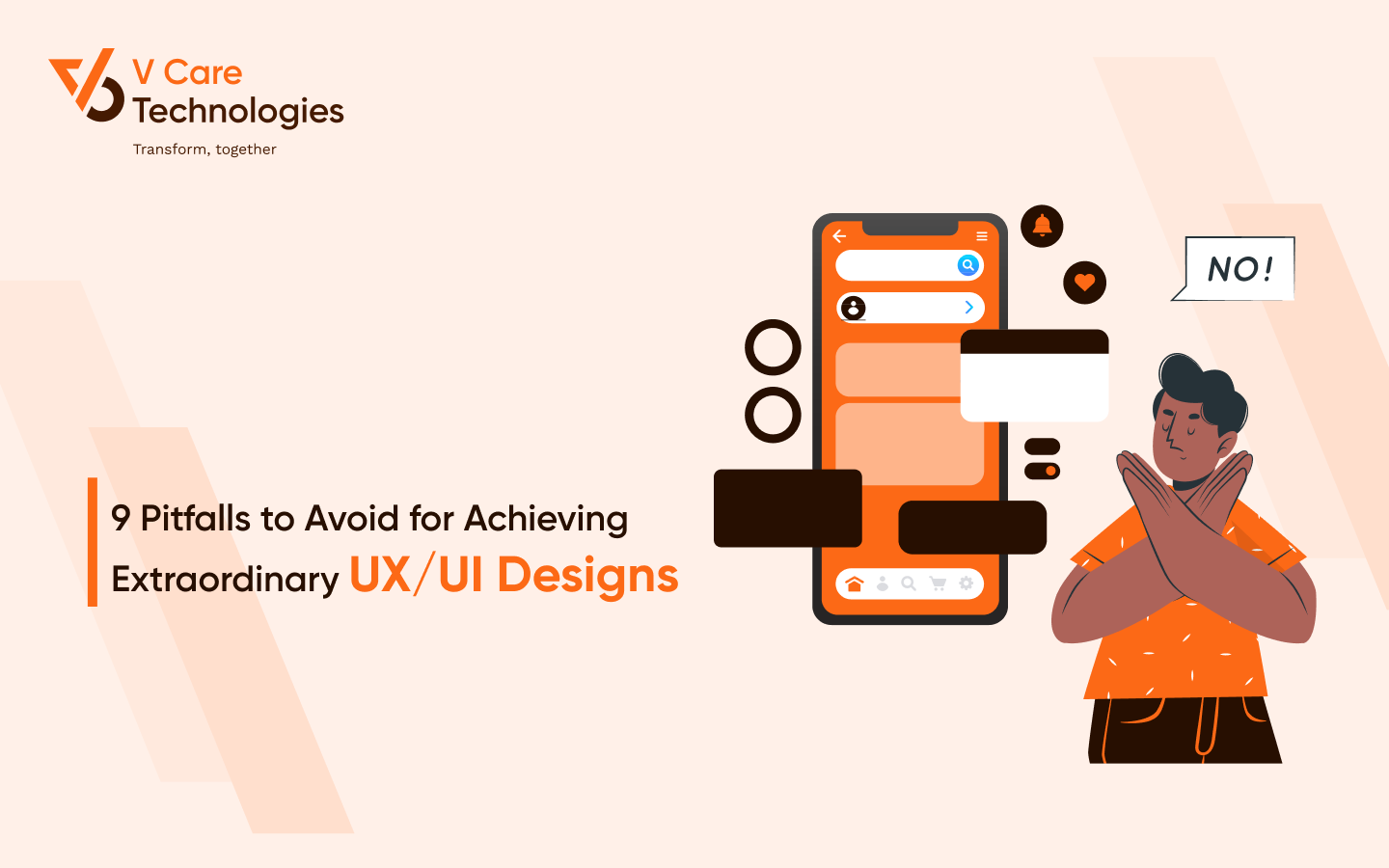9 Pitfalls to Avoid for Achieving Extraordinary UX/UI Designs
Introduction:
In the ever-evolving digital landscape, creating unique and captivating User Experience (UX) and User Interface (UI) designs is paramount to stand out from the competition. With the growing importance of digital products, a distinctive and memorable design can make or break a user's perception of a brand. However, achieving unique UX/UI designs requires avoiding certain pitfalls that can hinder creativity and innovation. In this blog post, we will explore five crucial things you should avoid if you aspire to create exceptional and unparalleled designs. Let's dive in!
1. Overlooking User Research
To truly create unique UX/UI designs, it is imperative to conduct thorough user research. Understanding your target audience, their needs, pain points, and preferences will provide invaluable insights that can shape your design decisions. Neglecting user research often leads to generic designs that fail to resonate with users. By analyzing user behavior, conducting surveys, and employing usability testing, you can gather actionable data to inform your design process. User research enables you to uncover unique opportunities and discover unmet user needs, ultimately driving innovation and differentiation.
2. Ignoring the Power of Storytelling
One common pitfall in UX/UI design is underestimating the impact of storytelling. Stories have a profound effect on human perception and memory retention. By incorporating storytelling elements into your design, you can create a memorable and engaging user experience. Whether it's through visual narratives, interactive animations, or compelling copy, weaving a story within your design fosters emotional connections and leaves a lasting impression on users. By avoiding this oversight, you can infuse your designs with a unique narrative that sets them apart from the competition.
3. Neglecting the Power of White Space
White space, also known as negative space, is a vital element of design that should never be overlooked. Some designers mistakenly believe that filling every inch of the screen with content is the key to an impressive design. However, white space is crucial in creating a balanced and harmonious layout. It allows elements to breathe and draws attention to the essential components of the interface. By embracing white space strategically, you can achieve a clean and minimalistic design that exudes elegance and sophistication, setting your designs apart from cluttered and overwhelming ones.
4. Shying Away from Experimentation
To achieve unique UX/UI designs, it is crucial to embrace experimentation and avoid falling into the trap of playing it safe. Designers who stick to conventional design patterns and shy away from pushing boundaries often end up with uninspiring and unremarkable outcomes. By experimenting with different layouts, color schemes, typography, and interaction patterns, you can create truly distinctive designs that captivate users' attention. Remember, innovation thrives on calculated risks and the willingness to explore uncharted territories.
5. Disregarding Accessibility Guidelines
Designing for inclusivity and accessibility should always be a priority when aiming for unique UX/UI designs. Ignoring accessibility guidelines not only excludes a significant portion of potential users but also limits the creative possibilities within your designs. By considering color contrast, font legibility, screen reader compatibility, and other accessibility factors, you can ensure your designs are inclusive and usable by a wide range of individuals. Designing with accessibility in mind not only enhances the overall user experience but also demonstrates a commitment to equal access and user-centered design principles.
6. Underestimating the Importance of Prototyping
Prototyping is a powerful tool in the UX/UI design process that allows designers to visualize and validate their ideas before implementation. Failing to incorporate prototyping into your workflow can lead to inefficient iterations, wasted time, and lackluster designs. By creating interactive prototypes, you can gather feedback early on, test usability, and make informed design decisions. This iterative process ensures that your designs evolve organically and reach their full potential, resulting in unique and user-centric outcomes.
7. Neglecting the Role of Microinteractions
Microinteractions, the subtle animations and feedback within a design, play a crucial role in enhancing the user experience. They provide visual cues, acknowledge user actions, and add a layer of delight to the overall interaction. Neglecting microinteractions can result in a static and unengaging design that fails to leave a lasting impression. By incorporating well-crafted microinteractions, such as subtle hover effects, progress indicators, or animated transitions, you can elevate your designs to new heights of uniqueness and interactivity.
8. Disregarding Cross-Platform Consistency
In today's multi-device world, designing for consistency across different platforms is essential to maintain a seamless user experience. Neglecting cross-platform consistency can lead to disjointed interactions, confusion, and a lack of trust in the product. By adhering to platform-specific design guidelines, maintaining consistent visual elements, and ensuring smooth transitions between devices, you can create a cohesive user experience that feels native and intuitive. Consistency across platforms not only enhances usability but also reinforces your brand identity, contributing to the uniqueness of your UX/UI designs.
9. Failure to Iterate and Evolve
The design process doesn't end with the launch of a product; it's an ongoing journey of continuous improvement. Failing to iterate and evolve your designs based on user feedback and changing market trends can result in stagnation and missed opportunities for uniqueness. By actively seeking user feedback, analyzing user behavior, and staying updated with the latest design trends, you can refine and enhance your designs to remain ahead of the curve. Embrace feedback as a catalyst for improvement and allow your designs to evolve, ensuring a fresh and unique UX/UI experience.
Conclusion:
Creating unique UX/UI designs requires a combination of user-centricity, innovation, and attention to detail. By avoiding the common pitfalls outlined in this blog post, you can set yourself on the path to achieving extraordinary designs that captivate and delight users. Remember, unique designs emerge from meticulous research, experimentation, storytelling, and a commitment to inclusivity and continuous improvement. Embrace the challenges, stay curious, and let your creativity soar to unlock new realms of UX/UI design innovation.
Ready to boost your digital presence and outshine your competitors? Look no further than V Care Technologies. As a trusted IT company, we specialize in web development, web design, app development, UX/UI design, and digital marketing services. Let our team of experts transform your ideas into engaging experiences that drive results. Take the leap towards success today. Contact V Care Technologies to discuss your project and unlock the full potential of your online business. Your journey to digital excellence starts here!
FAQ:
Q1: What is the importance of user research in UX/UI design?
A1: User research is crucial in understanding the needs and preferences of the target audience, informing design decisions, and driving innovation.
Q2: How can storytelling enhance UX/UI designs?
A2: Storytelling elements, such as visual narratives and compelling copy, create emotional connections and leave a lasting impression on users.
Q3: Why is white space important in design?
A3: White space creates balance, allows elements to breathe, and draws attention to essential components, resulting in a clean and elegant design.
Q4: Why should designers embrace experimentation?
A4: Experimentation pushes boundaries, fosters innovation, and leads to truly distinctive and captivating UX/UI designs.
Q5: What is the significance of designing for accessibility?
A5: Designing for accessibility ensures inclusivity and usability for a wide range of users, demonstrating a commitment to equal access and user-centered design.
Q6: How does prototyping contribute to unique UX/UI designs?
A6: Prototyping allows designers to visualize and validate ideas, gather early feedback, and ensure designs reach their full potential.
Q7: What role do microinteractions play in UX/UI designs?
A7: Microinteractions add subtle animations and feedback, enhancing the user experience and leaving a memorable impression.
Q8: Why is cross-platform consistency important in UX/UI design.
A8: Cross-platform consistency maintains a seamless user experience across different devices, reinforcing brand identity and enhancing usability.
Q9: How does iteration and evolution contribute to unique designs?
A9: Iteration based on user feedback and market trends ensures constant improvement, keeping designs fresh, relevant, and unique.
Q10: How can V Care Technologies help with UX/UI design and digital marketing?
A10: V Care Technologies offers expertise in web development, web design, app development, UX/UI design, and digital marketing to help businesses achieve exceptional online presence and stand out from the competition. Contact us to discuss your project requirements and unlock y our digital potential.
Author: Murtuza Tarwala
2023-06-06




 About us
About us Services
Services Projects
Projects Blogs
Blogs





